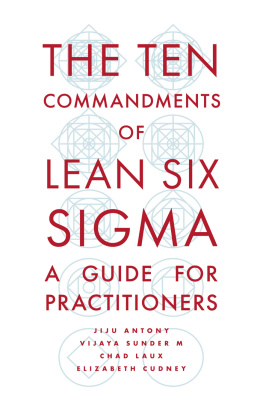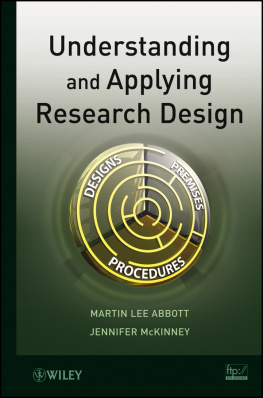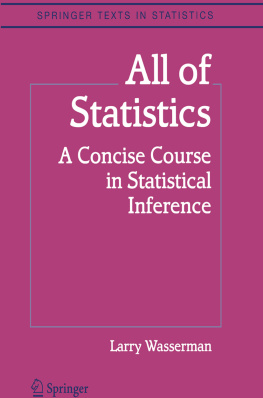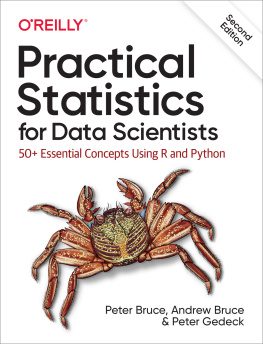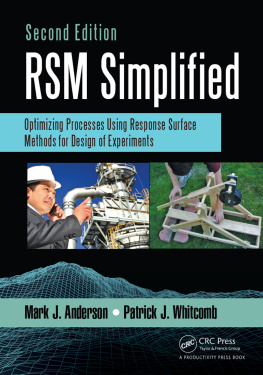School of Management and Languages, Heriot-Watt University, Edinburgh, Scotland, UK
Copyright
Elsevier
32 Jamestown Road, London NW1 7BY
225 Wyman Street, Waltham, MA 02451, USA
First edition 2003
Second edition 2014
Copyright 2014, 2003 Jiju Antony. Published by Elsevier Ltd. All rights reserved.
No part of this publication may be reproduced or transmitted in any form or by any means, electronic or mechanical, including photocopying, recording, or any information storage and retrieval system, without permission in writing from the publisher. Details on how to seek permission, further information about the Publishers permissions policies and our arrangement with organizations such as the Copyright Clearance Center and the Copyright Licensing Agency, can be found at our website: www.elsevier.com/permissions.
This book and the individual contributions contained in it are protected under copyright by the Publisher (other than as may be noted herein).
Notices
Knowledge and best practice in this field are constantly changing. As new research and experience broaden our understanding, changes in research methods, professional practices, or medical treatment may become necessary.
Practitioners and researchers must always rely on their own experience and knowledge in evaluating and using any information, methods, compounds, or experiments described herein.
In using such information or methods they should be mindful of their own safety and the safety of others, including parties for whom they have a professional responsibility.
To the fullest extent of the law, neither the Publisher nor the authors, contributors, or editors, assume any liability for any injury and/or damage to persons or property as a matter of products liability, negligence or otherwise, or from any use or operation of any methods, products, instructions, or ideas contained in the material herein.
British Library Cataloguing-in-Publication Data
A catalogue record for this book is available from the British Library
Library of Congress Cataloging-in-Publication Data
A catalog record for this book is available from the Library of Congress
ISBN: 978-0-08-099417-8
For information on all Elsevier publications visit our website at store.elsevier.com
This book has been manufactured using Print On Demand technology. Each copy is produced to order and is limited to black ink. The online version of this book will show color figures where appropriate.

Preface
Design of Experiments (DOE) is a powerful technique used for both exploring new processes and gaining increased knowledge of existing processes, followed by optimising these processes for achieving world-class performance. My involvement in promoting and training in the use of DOE dates back to the mid-1990s. There are plenty of books available in the market today on this subject written by classic statisticians, although the majority of them are better suited to other statisticians than to run-of-the-mill industrial engineers and business managers with limited mathematical and statistical skills.
DOE never has been a favourite technique for many of todays engineers and managers in organisations due to the number crunching involved and the statistical jargon incorporated into the teaching mode by many statisticians. This book is targeted to people who have either been intimidated by their attempts to learn about DOE or who have never appreciated the true potential of DOE for achieving breakthrough improvements in product quality and process efficiency.
This book gives a solid introduction to the technique through a myriad of practical examples and case studies. The second edition of the book has incorporated two new chapters and both cover the latest developments on the topic of DOE. Readers of this book will develop a sound understanding of the theory of DOE and practical aspects of how to design, analyse and interpret the results of a designed experiment. Throughout this book, the emphasis is on the simple but powerful graphical tools available for data analysis and interpretation. All of the graphs and figures in this book were created using Minitab version 15.0 for Windows.
I sincerely hope that practising industrial engineers and managers as well as researchers in academic world will find this book useful in learning how to apply DOE in their own work environment. The book will also be a useful resource for people involved in Six Sigma training and projects related to design optimisation and process performance improvements. In fact, I have personally observed that the number of applications of DOE in non-manufacturing sectors has increased significantly because of the methodology taught to Six Sigma professionals such as Six Sigma Green Belts and Black Belts.
The second edition has a chapter dedicated to DOE for non-manufacturing processes. As a mechanical engineer, I was not convinced about the application of DOE in the context of the service industry and public sector organisations including Higher Education. I have included a simple case study showing the power of DOE in a university setting. I firmly believe that DOE can be applied to any industrial setting, although there will be more challenges and barriers in the non-manufacturing sector compared to traditional manufacturing companies.
I hope that this book inspires readers to get into the habit of applying DOE for problem-solving and process troubleshooting. I strongly recommend that readers of this book continue on a more advanced reference to learn about topics which are not covered here. I am indebted to many contributors and gurus for the development of various experimental design techniques, especially Sir Ronald Fisher, Plackett and Burman, Professor George Box, Professor Douglas Montgomery, Dr Genichi Taguchi and Dr Dorian Shainin.
Acknowledgements
This book was conceived further to my publication of an article entitled Teaching Experimental Design Techniques to Engineers and Managers in the International Journal of Engineering Education. I am deeply indebted to a number of people who, in essence, have made this book what it is today. First, and foremost, I would like to thank a number of colleagues in both the academic and industrial worlds, as well as the research scholars I have supervised over the years, for their constant encouragement in writing up the second edition of the book. I am also indebted to the quality and production managers of the companies that I have been privileged to work with and gather data. I would also like to take this opportunity to thank my doctoral and other postgraduate students both on campus and off campus.
I would like to express my deepest appreciation to Hayley Grey and Cari Owen for their incessant support and forbearance during the course of this project. Finally, I express my sincere thanks to my wife, Frenie, and daughter, Evelyn, for their encouragement and patience as the book stole countless hours away from family activities.


